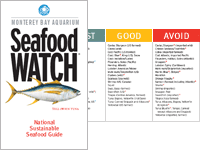New "Super Green" Seafood List from the Monterey Bay Aquarium
What to pick when you're buying seafood, from the nation's arbiter of sustainable seafood style, The Monterey Bay Aquarium:
 Download your pocket/wallet-sized regional Seafood Watch List here: http://www.montereybayaquarium.org/cr/cr_seafoodwatch/download.aspx
Download your pocket/wallet-sized regional Seafood Watch List here: http://www.montereybayaquarium.org/cr/cr_seafoodwatch/download.aspx
The "Super Green List," republished from the Aquarium's website:
****
Note: My old buddy Cory McNair, who's a chef in Pawley's Island, SC, had a comment worth sharing:
Thanks Cory!
 Download your pocket/wallet-sized regional Seafood Watch List here: http://www.montereybayaquarium.org/cr/cr_seafoodwatch/download.aspx
Download your pocket/wallet-sized regional Seafood Watch List here: http://www.montereybayaquarium.org/cr/cr_seafoodwatch/download.aspx The "Super Green List," republished from the Aquarium's website:
The Super Green List:
Connecting Human and Ocean Health
Seafood plays an important role in a balanced diet. It's often rich in omega-3 fatty acids, which help boost immunity and reduce the risk of heart disease, stroke, cancer and other ailments. Omega-3s are especially important for pregnant and nursing women, and young children. Unfortunately, some fish carry toxins that can become harmful when eaten frequently.
Good for You, Good for the Oceans
Combining the work of conservation and public health organizations, the Monterey Bay Aquarium has identified seafood that is "Super Green," meaning that it is good for human health and does not harm the oceans. The Super Green list highlights products that are currently on the Seafood Watch "Best Choices" (green) list, are low in environmental contaminants and are good sources of long-chain omega-3 fatty acids.
This effort draws from experts in human health, notably scientists from the Harvard School of Public Health (HSPH) and Environmental Defense Fund (EDF). The Monterey Bay Aquarium will continue to work with these organizations to balance the health and environmental attributes of seafood.
The Super Green list includes seafood that meets the following three criteria:
- Low levels of contaminants (below 216 parts per billion [ppb] mercury and 11 ppb PCBs)
- The daily minimum of omega-3s (at least 250 milligrams per day [mg/d])**
- Classified as a Seafood Watch "Best Choice" (green)
*The Best of the Best: October 2009
- Albacore Tuna (troll- or pole-caught, from the U.S. or British Columbia)
- Mussels (farmed)
- Oysters (farmed)
- Pacific Sardines (wild-caught)
- Pink Shrimp (wild-caught, from Oregon)
- Rainbow Trout (farmed)
- Salmon (wild-caught, from Alaska)
- Spot Prawns (wild-caught, from British Columbia)
*Other Healthy "Best Choices"
- Arctic Char (farmed)
- Bay Scallops (farmed)
- Crayfish (farmed, from the U.S.)
- Dungeness Crab (wild-caught, from California, Oregon or Washington)
- Longfin Squid (wild-caught, from the U.S. Atlantic)
- Pacific Cod (longline-caught, from Alaska)
*The "Super Green" list is based on dietary requirements for an average woman of childbearing age (18- 45, 154 pounds) eating 8 ounces of fish per week. The list also applies to men and children; children should eat age-appropriate portions to maximize their health benefits while minimizing risk.
Other Healthy "Best Choices" are low in contaminants and provide a smaller amount of omega-3s (between 100 and 250 mg/d, assuming 8 ounces of fish per week)
Contaminant data are from EDF, drawn from more than 250 government databases and peer-reviewed scientific studies on seafood contaminants.
Omega-3 data are primarily from the USDA Nutrient Database.
**Assumes 8 ounces of fish per week; 250 mg refers to the combined level of two omega-3s of primary importance to human health: eicosapentanoic acid (EPA) and docosahexanoic acid (DHA).
****
Note: My old buddy Cory McNair, who's a chef in Pawley's Island, SC, had a comment worth sharing:
"I would take this list with a grain of salt. It seems to sponsor a lot of west coast and Alaskan industries without regard to the efforts made in the southeast (on the SE sheet). US crayfish farming is nearly non-existent, they list Pacific Halibut as a fish to go for despite that its numbers are being depleted at a horrifying rate (to the point ... Read Morethat fishing moratorium talk keeps coming up). Though some fish do well in farmed environments (much rather have farmed tilapia than wild) I still am suspicious of the long term effects of farming many of the species they recommend (cobia? have you seen one? They are monsters, and need lots of swimming area.). I thought that it was interesting that wreckfish is the only Southeastern fish on the southeastern list that is recommended withouth concessions.
To be fair, I am looking at this as the SC legislature has been mulling over the idea of banning all commercial fishing of the Snapper/Grouper complex, including fishing charters. As an environmentalist, I hope they do it, as someone whose livelihood depends on these fish, I am worried.
In all, a good basic pocket guide for a consumer, but I hope that those that use this will care enough to look further into the various issues and problems in the industry, especially those that affect your immediate area."
Thanks Cory!


Comments
Post a Comment